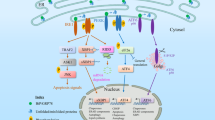Abstract
The lumen of the endoplasmic reticulum (ER) is a highly specialized compartment in eukaryotic cells. Here, secretory and most membrane proteins are folded, covalently modified, and oligomerized with the assistance of specialized ER resident proteins (1). Perturbation of the ER lumen interferes with the production of many essential cellular components and can thus be highly deleterious. Indeed, in humans, defects in protein folding in the ER can lead to devastating diseases, such as cystic fibrosis, alpha1-antitrypsin deficiency, and osteogenesis imperfecta (2). One way in which cells cope with the accumulation of unfolded proteins in the ER is by activating the unfolded protein response (UPR), an ER-to-nucleus signal transduction pathway (3–5). In the yeast Saccharomyces cerevisiae, Ire1p is an essential component of this pathway.
Similar content being viewed by others
References
Gething, M.-J. and Sambrook, J. (1992) Protein folding in the cell. Nature 355, 33–45.
Kuznetsov, G. and Nigam, S. K. (1998) Folding of secretory and membrane proteins. N. Engl. J. Med. 339, 1688–1695.
Shamu, C. E., Cox, J. S., and Walter, P. (1994) The unfolded protein response pathway in yeast. Trends Cell Biol. 4, 56–60.
Chapman, R., Sidrauski, C., and Walter, P. (1998) Intracellular signaling from the endo-plasmic reticulum to the nucleus. Annu. Rev. Cell Dev. Biol. 14, 459–485.
Sidrauski, C., Chapman, R., and Walter, P. (1998) The unfolded protein response: an intra-cellular signalling pathway with many surprising features. Trends Cell Biol. 8, 245–249.
Cox, J. S., Shamu, C. E., and Walter, P. (1993) Transcriptional induction of genes encoding endoplasmic reticulum resident proteins requires a transmembrane protein kinase. Cell 73, 1197–1206.
Mori, K., Ma, W., Gething, M. J., and Sambrook, J. (1993) A transmembrane protein with a cdc2+/CDC28-related kinase activity is required for signaling from the ER to the nucleus. Cell 74, 743–756.
Bork, P. and Sander, C. (1993) A hybrid protein kinase-RNase in an interferon-induced pathway? FEBS Lett. 334, 149–152.
Sidrauski, C. and Walter, P. (1997) The transmembrane kinase Ire1p is a site-specific endo-nuclease that initiates mRNA splicing in the unfolded protein response. Cell 90, 1–20.
Shamu, C. E. and Walter, P. (1996) Oligomerization and phosphorylation of the Ire1p kinase during intracellular signaling from the endoplasmic reticulum to the nucleus. EMBO J. 15, 3028–3039.
Mori, K., Sant, A., Kohno, K., Normington, K., Gething, M. J., and Sambrook, J. F. (1992) A 22 bp cis-acting element is necessary and sufficient for the induction of the yeast KAR2 (BiP) gene by unfolded proteins. EMBO J. 11, 2583–2593.
Kohno, K., Normington, K., Sambrook, J., Gething, M. J., and Mori, K. (1993) The promoter region of the yeast KAR2 (BiP) gene contains a regulatory domain that responds to the presence of unfolded proteins in the endoplasmic reticulum. Mol. Cell Biol. 13, 877–890.
Cox, J. S. and Walter, P. (1996) A novel mechanism for regulating activity of a transcription factor that controls the unfolded protein response. Cell 87, 391–404.
Nikawa, J., Akiyoshi, M., Hirata, S., and Fukuda, T. (1996) Saccharomyces cerevisiae IRE2/HAC1 is involved in IRE1-mediated KAR2 expression. Nucleic Acids Res. 24, 4222–4226.
Kawahara, T., Yanagi, H., Yura, T., and Mori, K. (1997) Endoplasmic reticulum stress-induced mRNA splicing permits synthesis of transcription factor Hac1p/Ern4p that activates the unfolded protein response. Mol. Biol. Cell 8, 1845–1862.
Chapman, R. E. and Walter, P. (1997) Translational attenuation mediated by an mRNA intron. Curr. Biol. 7, 850–859.
Gonzalez, T. N., Sidrauski, C., Dörfler, S., and Walter, P. (1999) Mechanism of non-spliceosomal mRNA splicing in the unfolded protein response pathway. EMBO J. 18, 3119–3132.
Moore, M. J., Query, C. C., and Sharp, P. A. (1993) Splicing of precursors to mRNA by the spliceosome, in The RNA World (Gesteland, R. F. and Atkins, J. F., eds.), Cold Spring Harbor Laboratory, Cold Spring Harbor, NY, pp. 303–357.
Westaway, S. K. and Abelson, J. (1995) Splicing of tRNA precursors, in tRNA: Structure, Biosynthesis, and Function (Söll, D. and RajBhandary, U., eds.), ASM Press, Washington, DC, pp. 79–92.
Abelson, J., Trotta, C. R., and Li, H. (1998) tRNA splicing. J. Biol. Chem. 273, 12,685–12,688.
Dong, B. and Silverman, R. H. (1997) A bipartite model of 2–5A-dependent RNase L. J. Biol. Chem. 272, 22,236–22,242.
Dong, B., Xu, L., Zhou, A., Hassel, B. A., Lee, X., Torrence, P. F., and Silverman, R. H. (1994) Intrinsic molecular activities of the interferon-induced 2–5A-dependent RNase. J. Biol. Chem. 269, 14,153–14,158.
Dong, B. and Silverman, R. H. (1999) Alternative function of a protein kinase homology domain in 2′, 5′-oligoadenylate dependent RNase L. Nucleic Acids Res. 27, 439–445.
Milligan, J. F., Groebe, D. R., Witherell, G. W., and Ulhlenbeck, O. C. (1987) Oligoribonucleotide synthesis using T7 RNA polymerase and synthetic DNA templates. Nucleic Acids Res. 15, 8783–8798.
Author information
Authors and Affiliations
Editor information
Editors and Affiliations
Rights and permissions
Copyright information
© 2001 Humana Press Inc.
About this protocol
Cite this protocol
Gonzalez, T.N., Walter, P. (2001). Ier1 p: A Kinase and Site-Specific Endoribonuclease. In: Schein, C.H. (eds) Nuclease Methods and Protocols. Methods in Molecular Biology™, vol 160. Humana Press. https://doi.org/10.1385/1-59259-233-3:025
Download citation
DOI: https://doi.org/10.1385/1-59259-233-3:025
Publisher Name: Humana Press
Print ISBN: 978-0-89603-679-6
Online ISBN: 978-1-59259-233-3
eBook Packages: Springer Protocols




